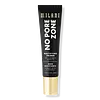What's inside
What's inside
 Key Ingredients
Key Ingredients

 Benefits
Benefits

 Concerns
Concerns

 Ingredients Side-by-side
Ingredients Side-by-side

Dimethicone
EmollientDisiloxane
Skin ConditioningIsononyl Isononanoate
EmollientDimethicone Crosspolymer
Emulsion StabilisingHdi/Trimethylol Hexyllactone Crosspolymer
Silica
AbrasiveLilium Candidum Leaf Cell Extract
Skin ConditioningBambusa Arundinacea Stem Extract
Skin ConditioningSilica Dimethyl Silylate
EmollientGlycerin
HumectantSodium Hyaluronate
HumectantTocopherol
AntioxidantEthylhexyl Palmitate
EmollientButylene Glycol
HumectantCaprylyl Glycol
EmollientHexylene Glycol
EmulsifyingPhenoxyethanol
PreservativeEthylhexylglycerin
Skin ConditioningDimethicone, Disiloxane, Isononyl Isononanoate, Dimethicone Crosspolymer, Hdi/Trimethylol Hexyllactone Crosspolymer, Silica, Lilium Candidum Leaf Cell Extract, Bambusa Arundinacea Stem Extract, Silica Dimethyl Silylate, Glycerin, Sodium Hyaluronate, Tocopherol, Ethylhexyl Palmitate, Butylene Glycol, Caprylyl Glycol, Hexylene Glycol, Phenoxyethanol, Ethylhexylglycerin
Water
Skin ConditioningGlycerin
HumectantSilica
AbrasiveButylene Glycol
HumectantPEG-150 Distearate
EmulsifyingNiacinamide
SmoothingPolysorbate 80
EmulsifyingBackhousia Citriodora Leaf Extract
AstringentTocopherol
AntioxidantEthylhexylglycerin
Skin ConditioningCaprylyl Glycol
EmollientPotassium Laurate
EmulsifyingAmmonium Acryloyldimethyltaurate/Vp Copolymer
PEG-240/Hdi Copolymer Bis-Decyltetradeceth-20 Ether
StabilisingPhenoxyethanol
PreservativeDisodium EDTA
Water, Glycerin, Silica, Butylene Glycol, PEG-150 Distearate, Niacinamide, Polysorbate 80, Backhousia Citriodora Leaf Extract, Tocopherol, Ethylhexylglycerin, Caprylyl Glycol, Potassium Laurate, Ammonium Acryloyldimethyltaurate/Vp Copolymer, PEG-240/Hdi Copolymer Bis-Decyltetradeceth-20 Ether, Phenoxyethanol, Disodium EDTA
Ingredients Explained
These ingredients are found in both products.
Ingredients higher up in an ingredient list are typically present in a larger amount.
Butylene Glycol (or BG) is used within cosmetic products for a few different reasons:
Overall, Butylene Glycol is a safe and well-rounded ingredient that works well with other ingredients.
Though this ingredient works well with most skin types, some people with sensitive skin may experience a reaction such as allergic rashes, closed comedones, or itchiness.
Learn more about Butylene GlycolCaprylyl Glycol is a humectant and emollient, meaning it attracts and preserves moisture.
It is a common ingredient in many products, especially those designed to hydrate skin. The primary benefits are retaining moisture, skin softening, and promoting a healthy skin barrier.
Though Caprylyl Glycol is an alcohol derived from fatty acids, it is not the kind that can dry out skin.
This ingredient is also used as a preservative to extend the life of products. It has slight antimicrobial properties.
Learn more about Caprylyl GlycolEthylhexylglycerin (we can't pronounce this either) is commonly used as a preservative and skin softener. It is derived from glyceryl.
You might see Ethylhexylglycerin often paired with other preservatives such as phenoxyethanol. Ethylhexylglycerin has been found to increase the effectiveness of these other preservatives.
Glycerin is already naturally found in your skin. It helps moisturize and protect your skin.
A study from 2016 found glycerin to be more effective as a humectant than AHAs and hyaluronic acid.
As a humectant, it helps the skin stay hydrated by pulling moisture to your skin. The low molecular weight of glycerin allows it to pull moisture into the deeper layers of your skin.
Hydrated skin improves your skin barrier; Your skin barrier helps protect against irritants and bacteria.
Glycerin has also been found to have antimicrobial and antiviral properties. Due to these properties, glycerin is often used in wound and burn treatments.
In cosmetics, glycerin is usually derived from plants such as soybean or palm. However, it can also be sourced from animals, such as tallow or animal fat.
This ingredient is organic, colorless, odorless, and non-toxic.
Glycerin is the name for this ingredient in American English. British English uses Glycerol/Glycerine.
Learn more about GlycerinPhenoxyethanol is a preservative that has germicide, antimicrobial, and aromatic properties. Studies show that phenoxyethanol can prevent microbial growth. By itself, it has a scent that is similar to that of a rose.
It's often used in formulations along with Caprylyl Glycol to preserve the shelf life of products.
Silica, also known as silicon dioxide, is a naturally occurring mineral. It is used as a fine, spherical, and porous powder in cosmetics.
Though it has exfoliant properties, the function of silica varies depending on the product.
The unique structure of silica enhances the spreadability and adds smoothness, making it a great texture enhancer.
It is also used as an active carrier, emulsifier, and mattifier due to its ability to absorb excess oil.
In some products, tiny microneedles called spicules are made from silica or hydrolyzed sponge. When you rub them in, they lightly polish away dead skin layers and enhance the penetration of active ingredients.
Learn more about SilicaTocopherol (also known as Vitamin E) is a common antioxidant used to help protect the skin from free-radicals and strengthen the skin barrier. It's also fat soluble - this means our skin is great at absorbing it.
Vitamin E also helps keep your natural skin lipids healthy. Your lipid skin barrier naturally consists of lipids, ceramides, and fatty acids. Vitamin E offers extra protection for your skin’s lipid barrier, keeping your skin healthy and nourished.
Another benefit is a bit of UV protection. Vitamin E helps reduce the damage caused by UVB rays. (It should not replace your sunscreen). Combining it with Vitamin C can decrease sunburned cells and hyperpigmentation after UV exposure.
You might have noticed Vitamin E + C often paired together. This is because it is great at stabilizing Vitamin C. Using the two together helps increase the effectiveness of both ingredients.
There are often claims that Vitamin E can reduce/prevent scarring, but these claims haven't been confirmed by scientific research.
Learn more about Tocopherol